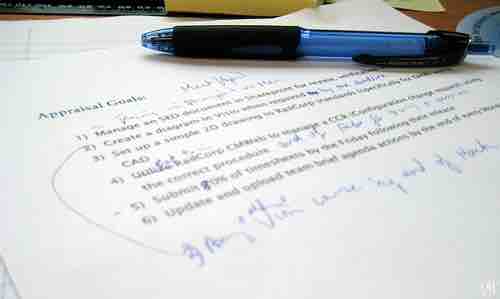Goal Setting Theory
Setting goals affects outcomes in four ways:
- Choice: Goals direct efforts towards goal-relevant activities and away from distractions.
- Effort: Goals can lead to more effort; for example, if one typically produces four widgets an hour, and has the goal of producing six, one may work more efficiently as a result.
- Persistence: People become more likely to work through setbacks if pursuing a goal.
- Cognition: Goals can lead individuals to develop and change their behavior.
Goals that are difficult to achieve and specific tend to increase performance more than goals that are not. A goal can become more specific through quantification or enumeration (should be measurable), such as by demanding "...increase productivity by 50%," or by defining certain tasks that must be completed.

Goal-Setting Theory
Goals lead to higher performance in an organization.
Psychologists have examined the behavioral effects of goal-setting, concluding in 90% of laboratory and field studies that specific and challenging goals led to higher performance than when the goals were easy or did not exists.
While some managers believe it is sufficient to urge employees to "do their best," psychologists have disagreed on this style's effectiveness. Some psychologists have found that people who are told to "do their best" don't. To elicit some specific form of behavior from others, it is important that all employees have a clear understanding what is expected. "Doing their best" does not provide that clear measure. A goal is important because it establishes a specified direction and measure of performance.
However, when goals are established at a management level and thereafter solely laid down, employee motivation with regard to achieving these goals is rather suppressed. To increase motivation, employees must be involved in the goal setting process and the goals must be challenging as well.
People perform better when they are committed to achieve certain goals. Goal commitment is dependent on:
- Importance of the expected outcomes of goal attainment
- Self-efficacy – one's belief that he is able to achieve the goals
- Commitment to others – promises or engagements to others can strongly improve commitment
- Feedback - keep track of performance to allow employees to see how effective they have been in attaining the goals to ensure that any deficiencies are quickly corrected.
- Task complexity - more difficult goals require more cognitive strategies and well-developed skills. The more difficult the tasks, the smaller the group of people who possess the necessary skills and strategies. From an organizational perspective it is thereby more difficult to successfully attain more difficult goals since resources become more scarce.
- Employee motivation - the more employees are motivated, the more they are stimulated and interested in accepting goals.
These success factors are interdependent. For example the expected outcomes of goals are positively influenced when employees are involved in the goal setting process. Not only does participation increase commitment in attaining the goals that are set, participation influences self-efficacy as well.
Goal-commitment, the most influential moderator, becomes especially important when dealing with difficult or complex goals. If people lack commitment to goals, they lack motivation to reach them. To commit to a goal, one must believe in its importance or significance.
The enhancement of performance through goals requires feedback. Goal setting and feedback go hand in hand. Without feedback, goal setting is unlikely to work. Providing feedback on short-term objectives helps to sustain motivation and commitment to a goal. Besides, feedback should be provided on the strategies followed to achieve the goals and the final outcomes achieved as well. Feedback on strategies to obtain goals is very important, especially for complex work, because challenging goals put focus on outcomes rather than on performance strategies, so they impair performance.
Proper feedback is also very essential, and the following hints may help for providing a good feedback:
- Create a positive context for feedback.
- Use constructive and positive language.
- Focus on behaviors and strategies.
- Tailor feedback to the needs of the individual worker.
- Make feedback a two-way communication process.
Goal-setting may have little effect if individuals can't see the state of their performance in relation to the goal. By gauging their performance, individuals can determine whether they need to work harder or changing their methods.
Goal-setting theory has limitations. In an organization, a goal of a manager may not align with the goals of the organization as a whole. In such cases, the goals of an individual may come into direct conflict with the employing organization. Without aligning goals between the organization and the individual, performance may suffer. Moreover, for complex or creative tasks, goal-setting may actual impair performance because the individual may become preoccupied with meeting goals and not performing tasks.